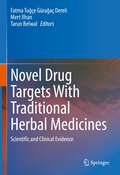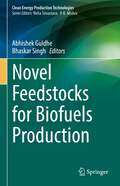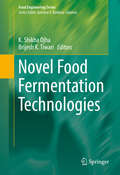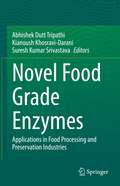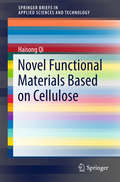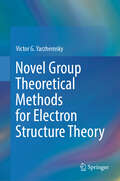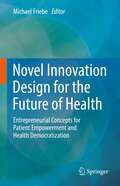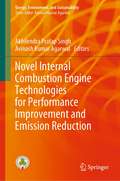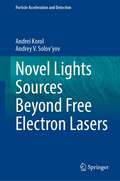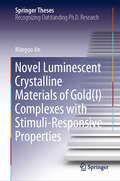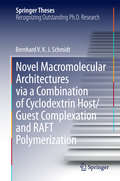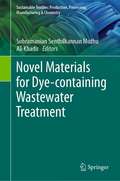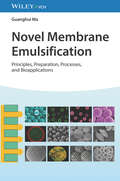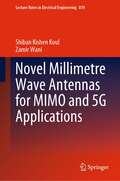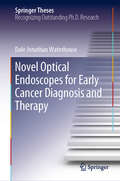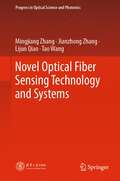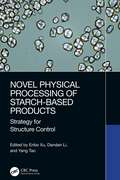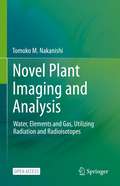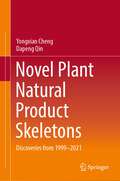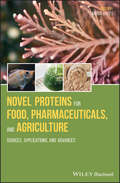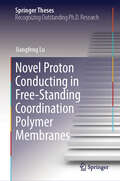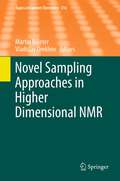- Table View
- List View
Novel Drug Targets With Traditional Herbal Medicines: Scientific and Clinical Evidence
by Tarun Belwal Fatma Tuğçe Gürağaç Dereli Mert IlhanThis book collects information about the most popular ethnomedicinal plants, which are common in Turkey and around the world. It presents the ethnopharmacological records, in vivo and in vitro studies, side effects, chemical compositions and clinical studies of these medicinal plants. Its special focus is on the novel drug targets for disease and their possible mechanisms of action. It covers botanical descriptions the status of the plants, and food or drug interactions including precautions and warnings about the plants and the available market products. It provides an explanation of recorded and known plant administration dosages. Also, the gap between the traditional practice and scientific/clinical evidences in the use of ethnomedicinal plant is acknowledged.It is well known that traditional knowledge of the use of the medicinal plants in therapy is an important resource for the discovery of novel treatment options and drug targets. The main purpose of this book is to draw attention to ethnomedicinal plant species. Data on the therapeutic potentials of these medicinal plants can now be accessed from a single source. It provides an important resource for future research opportunities for harnessing the full potential of these plants.
Novel Feedstocks for Biofuels Production (Clean Energy Production Technologies)
by Bhaskar Singh Abhishek GuldheThis book critically evaluates recently investigated feedstock for biofuels production. Biofuel sector is rapidly evolving to cater the renewable energy demands. Novel and advanced feedstock are being investigated for their techno-economic feasibility. Environmental concerns, food vs fuel debate, energy security, economic feasibility, and availability are the major drivers for exploring different feedstock for biofuel production. This book explores a wide range of potential biofuels feedstock, their functional concepts, recent advancement, novel technique and critical evaluation with other available biofuel feedstock. This book also discusses future prospects of biofuel production. It is a useful read for students, researchers, faculty, industry and policy makers in the biofuel field.
Novel Food Fermentation Technologies
by Brijesh K. Tiwari K. Shikha OjhaNovel Food Fermentation Technologies provides a comprehensive overview of innovations in food fermentation technologies and their application. Current novel technologies for microbial culture production and preservation are covered in detail, as are fermentation techniques for the production of bioactives from various food matrices, including food processing by-products and waste. Readers are provided with a close look at thermal and non-thermal technologies applicable to fermented food products. The text covers immobilization, microencapsulation technologies, and novel preservation techniques for cultures in fermentation. In-depth studies of high pressure processing, pulsed electric field, power ultrasound and gamma irradiation in fermentation are provided in addition to novel thermal and non-thermal technologies and process analytical techniques. A wide variety of fermented products are covered, including meat, marine-based, grain-based, dairy, and vegetable-based products. Current technologies for extraction of bioactives are examined, as are current innovations in fermented food packaging. Readers are presented with current and future challenges in food fermentation as well. As a comprehensive reference for food fermentation, this work provides up-to-date insights into emerging fermentation technologies which facilitate the processing of wholesome and safe food products.
Novel Food Grade Enzymes: Applications in Food Processing and Preservation Industries
by Abhishek Dutt Tripathi Kianoush Khosravi-Darani Suresh Kumar SrivastavaThis book covers all the aspects of food-grade enzymes, including their classification, kinetics, microbial production, biosynthetic pathways, commodity-wise industrial applications, and downstream processing strategies. The broad focus of this book is on the application of various classes of enzymes in dairy, fruits and vegetables, cereals and oilseeds, meat and poultry, and brewing and food packaging industries. Certain recent areas such as nanotechnological perspective in enzyme immobilization, infusion strategies as well as its efficient usage in food packaging and preservation are some of the salient highlights of this book. This book also discusses the aspects related to application of enzymes in functional food development and shelf life extension of various commodities food products. This book is beneficial for researchers, students, entrepreneurs, and industry experts in broad disciplines such as food processing, food biotechnology, food microbiology, biochemistry, agriculture, biotechnology, biochemical engineering, and bioprocess technology.
Novel Foods in the European Union (SpringerBriefs in Molecular Science)
by Giorgia Caruso Daniele PisanelloThis Brief describes in three concise chapters one of the newest ‘hot topics’ under EU Food Law and Policy: the new Regulation (EU) No 2015/2283 from the European Parliament and by the Council, November 25, 2015, on novel foods, applicable from January 2018. In this work, the Authors discuss the long-time criticized EU Regulation on novel foods ((EC) No 258/1997) and how it has been significantly altered by the adoption of the new regulation. In the first chapter, the Authors provide a comprehensive analysis of the genesis of the new Regulation, its rationale and the policy’s goals. In particular, they describe what food business operators shall do in order to get a new product allowed on the EU market, providing updated information on the regulatory developments from the European Food Safety Authority in nanofoods, cloned animals and insect foods. The role of the European Food Safety Authority is also discussed. The second Chapter summarizes the current toxicological studies used to evaluate novel foods safety, which are an extremely important pillar when speaking of food safety and commercial introduction of new products. Finally, the third Chapter discusses the ‘history of safe use’ approach to the problem of novel foods, and factors such as consumption period analysis, preparation advices and processes, intake levels, nutritional composition, and results of animal studies. Food lawyers, professionals and auditors working in the area of official inspections, quality assurance, food traceability, and international regulation, both in academia and industry, will find this Brief an important account.
Novel Functional Materials Based on Cellulose
by Haisong QiThis Brief presents a review of new eco-friendly processes, design and applications for novel cellulose-based materials, including regenerated materials, composites, nanocellulose and cellulose derivatives. Application of these materials in smart textiles, packaging, energy storage, sensors, gas separations, tissue engineering and drug release are highlighted.
Novel Group Theoretical Methods for Electron Structure Theory
by Victor G. YarzhemskyThis book presents the induced representation method, a powerful technique in quantum mechanics with applications in condensed matter physics. After introducing the key concepts in group theory and representation theory necessary to understate the technique, the author goes on to explore applications in electron structure theory, namely: basis sets in clusters, normal vibrations, selection rules, two-electron wavefunctions, and space-group representations. This technique allows the simplification of standard techniques for the analysis of molecular orbitals and normal vibrations of molecules. A space group approach to the wavefunction of a Cooper pair based on the Anderson ansatz and Mackey-Bradley theorem is developed, and several applications are considered, namely group-theoretical nodes, non-symmorphic groups, and unification of the group theoretical and topological approaches to the structure of Cooper pairs in unconventional superconductors.
Novel Innovation Design for the Future of Health: Entrepreneurial Concepts for Patient Empowerment and Health Democratization
by Michael FriebeThis book highlights the reasons for an urgently needed revision of the current global healthcare setup, discusses the needed mindset for a future of health, and provides a comprehensive development toolset for disruption (and for the needed incremental innovations towards disruption).Today’s biomedical and health innovation related research in universities encourages activities that lead to incremental innovations with a relatively low risk of failure. The healthcare industry on the other hand provides tools and devices for established healthcare providers to improve the diagnosis and therapy/ treatment of the patients’ health problems. The patient is not in the center of healthcare provision however, and prevention and prediction are not core goals. The current health setup needs to be challenged and disrupted.Disruptions are coming from technologies or processes that lead to a significant (>10x) reduction in cost or price/ performance and that also come with new business models. The need for change, effects of exponential technologies, and the needed shift to prevention and to homecare for health democratization and patient empowerment will be discussed in detail in the first parts of the book. The subsequent sections address several innovation methods with a focus on a novel meta methodology named Purpose Launchpad Health. This is followed by a comprehensive discussion on health entrepreneurship activities and needs. The final section of the book addresses how to train students to become entrepreneurial health innovators, presenting successful curricula and examples of health incubation and accelerator setups. All of the innovation tools presented and used in this book are summarized in the final chapter to help the reader get started planning an entrepreneurial venture.Written by experts from academia and industry, the book covers important basics and best practices, as well as recent developments. Chapters are concise and enriched with key messages, learning objectives and real innovation examples to bridge theory and practice. This book aims to serve as a teaching base for health innovation design and to prepare for health-related entrepreneurial ventures.Readers with medical, biomedical, biotechnology, and health economics backgrounds - and anyone who wants to become a future oriented health innovator or who believes in disruptive approaches - will find this book a useful resource and teaching tool for developing validated products/ services and processes for the future of health.
Novel Internal Combustion Engine Technologies for Performance Improvement and Emission Reduction (Energy, Environment, and Sustainability)
by Avinash Kumar Agarwal Akhilendra Pratap SinghThis monograph covers different aspects of internal combustion engines including engine performance and emissions and presents various solutions to resolve these issues. The contents provide examples of utilization of methanol as a fuel for CI engines in different modes of transportation, such as railroad, personal vehicles or heavy duty road transportation. The volume provides information about the current methanol utilization and its potential, its effect on the engine in terms of efficiency, combustion, performance, pollutants formation and prediction. The contents are also based on review of technologies present, the status of different combustion and emission control technologies and their suitability for different types of IC engines. Few novel technologies for spark ignition (SI) engines have been also included in this book, which makes this book a complete solution for both kind of engines. This book will be useful for engine researchers, energy experts and students involved in fuels, IC engines, engine instrumentation and environmental research.
Novel Lights Sources Beyond Free Electron Lasers (Particle Acceleration and Detection)
by Andrey V. Solov'yov Andrei KorolThis book discusses possibilities and perspectives for designing and practical realization of novel intensive gamma-ray crystal-based light sources that can be constructed through exposure of oriented crystals—linear, bent and periodically bent, to beams of ultrarelativistic positrons and electrons.The book shows case studies like the tunable light sources based on periodically bent crystals that can be designed with the state-of-the-art beam facilities. A special focus is given to the analysis of generation of the gamma rays because the current technologies based on particle motion in the magnetic field become inefficient or incapable to achieve the desired gamma rays’ intensities. It is demonstrated that the intensity of radiation from crystal-based light sources can be made comparable to or even higher than what is achievable in conventional synchrotrons and undulators operating although in the much lower photon energy range. By exploring the coherence effects, the intensity can be boosted by orders of magnitude. The practical realization of such novel light sources will lead to the significant technological breakthroughs and societal impacts similar to those created earlier by the developments of lasers, synchrotrons and X-rays free-electron lasers.Readers learn about the underlying fundamental physics and familiarize with the theoretical, experimental and technological advances made during last two decades in exploring various features of investigations into crystal-based light sources. This research draws upon knowledge from many research fields, such as material science, beam physics, physics of radiation, solid-state physics and acoustics, to name but a few. The authors provide a useful introduction in this emerging field to a broad readership of researchers and scientists with various backgrounds and, accordingly, make the book as self-contained as possible.
Novel Luminescent Crystalline Materials of Gold (Springer Theses)
by Mingoo JinThis book highlights and investigates novel solid-state luminescent properties of crystals with stimuli-responsive behavior. Several novel molecular designs for controlling crystal structures with photo-physical properties are described, with a special focus on external stimuli-responsive properties. The major goal of the material design concept was to capitalize on the chirality of crystals with stimuli-responsive properties. To allow crystals’ chirality to be controlled and modified by means of external stimulation, the axial chirality of biaryl moiety was employed and, interestingly, produced several novel mechano- and vapo-responsive luminescent properties based on crystal-to-crystal or single-crystal-to-single-crystal phase transitions. In addition, the book details how the molecular rotation of luminophores in the solid phase can be used to achieve corresponding thermal-responsive phosphorescence. The reports presented here illustrate how the author has succeeded in controlling structural factors in a bulk environment by using molecular design with linking to photo-physical properties. The content will be of great interest to researchers in the field, and to members of chemical and material science societies.
Novel Macromolecular Architectures via a Combination of Cyclodextrin Host/Guest Complexation and RAFT Polymerization
by Bernhard V. K. J. SchmidtIn this thesis, Bernhard Schmidt describes his research into two fields in the chemical sciences: supramolecular and macromolecular chemistry. Schmidt first investigates cyclodextrins (CDs), which are well known for the formation of supramolecular host/guest complexes with hydrophobic molecules in aqueous solution. Schmidt then also examines reversible addition-fragmentation chain transfer (RAFT) polymerization as a well-suited toll for the synthesis of water-soluble end-functionalized polymers. The author skillfully combines both concepts as a powerful tool to access reversibly forming macromolecular architectures. The novel methods and architectures presented in this work are highly interesting from both a fundamental point of view as well as a basis for the design of efficient drug release systems. The work in this thesis has led to a number of publications in top peer-reviewed journals.
Novel Materials for Dye-containing Wastewater Treatment (Sustainable Textiles: Production, Processing, Manufacturing & Chemistry)
by Subramanian Senthilkannan Muthu Ali KhadirThis book highlights novel materials for dye-containing wastewater treatment and presents an up-to-date information on dye degradation/adsorption using new promising materials such as nanocomposites. Development of various industrial sectors, including textile, food, paper, leather, rubber, cosmetic and printing has led to generation of wastewater which contain dye molecules as well as other inorganic and organic compounds. Considering serious health hazards and environmental damage associated with dyes in the environment, researchers and professionals have been attempting to find the most effective methods of treatment. Of late, various composites have received wide attention due to their outstanding properties in wastewater treatment, that are presented in this book.
Novel Membrane Emulsification: Principles, Preparation, Processes, and Bioapplications
by Guanghui MaNovel Membrane Emulsification Comprehensive resource presenting state-of-the-art of membrane emulsification technology, from principle to practice, with focus on biomedical applications Novel Membrane Emulsification: Principles, Preparation, Processes, and Bioapplications provides comprehensive coverage of membrane emulsification technology by summarizing the principle, preparation, and bioapplications through utilizing uniform particle size, introducing recent development in preparation and applications in the controlled release and delivery of protein/peptide, anticancer drugs and vaccines, and in the bioseparation media and cell culture carriers, and discussing direct, rapid, and rotary membrane emulsification equipments. Novel Membrane Emulsification includes information on: Preparation of hydrophobic microspheres from O/W emulsion, hydrophilic microspheres from W/O emulsion, and microcapsules/composite microspheres from double emulsions, covering preparation from monomer and preformed polymer systems Preparation of small particles by rapid membrane emulsification process Applications of uniform particles in sustained release of protein/peptide drugs, covering strategies to improve encapsulation efficiency and maintain bioactivity of drugs Applications of uniform particles in anticancer drug and vaccine delivery including personalized therapeutic vaccine Applications of uniform particles in protein separation, covering uniform agarose microsphere for protein separation and super-porous microsphere for vaccine separation Novel Membrane Emulsification is an essential resource for scientists and researchers in multiple fields, particularly chemistry, chemical engineering, and materials science, to advance this technique and produce novel materials with controlled characteristics. The text is also a valuable learning resource for biomedical science and bioengineering researchers and students.
Novel Millimetre Wave Antennas for MIMO and 5G Applications (Lecture Notes in Electrical Engineering #819)
by Shiban Kishen Koul Zamir WaniThis book presents state-of-the-art millimetre wave antennas for next generation 5G communications. The propagation losses associated with the millimetre waves and the signal blockage due to the objects present between transmitter and receiver require novel antenna topologies to address these issues. Various aspects of antenna design related to millimetre wave 5G communication including 28-GHz channel characteristics, mmWave antenna requirements, antenna design strategies for 28 GHz, MIMO/multibeam antennas, and mmWave lens antennas are highlighted. Apart from the general antenna requirements and study related to the 28 GHz frequency band, various new metamaterial-based antennas employing uniaxial or biaxial anisotropic media that enhance the antenna radiation performance are covered in detail. In addition, various new antenna systems such as wide-scan antenna arrays, dual-polarized antennas, and dual-beam/multibeam antennas are covered in this book. The book concludes with the glimpses of the millimetre wave lens antennas and the design of very thin planar metamaterial lens for 5G massive MIMO applications.
Novel Optical Endoscopes for Early Cancer Diagnosis and Therapy (Springer Theses)
by Dale Jonathan WaterhouseThis thesis describes the design, development, characterisation and clinical translation of three novel devices for optical endoscopic imaging. Over the past decade, rapid innovation in optics and photonics has led to the availability of low-cost and high-performance optical technologies that can be exploited for biomedical applications, but relatively few have been translated into clinic. The work presented outlines for the first time, a comprehensive analysis of the common barriers and unique challenges associated with the translation of optical imaging techniques. To assist developers streamline translation of optical imaging devices in future, a roadmap to clinical translation is outlined, and key translational characteristics are defined. Guided by these, subsequent development of endoscopic devices resulted in preparation and approval of endoscopes for first in human trials in the oesophagus, for early detection of cancer, and in the brain, for delineation of tumour during surgical resection. The thesis culminates in the presentation of results from the first in human use of a compact multispectral endoscope for imaging endogenous tissue contrast in the oesophagus. With continuation of the work as outlined at the end of this thesis, the novel techniques described have the potential to improve the standard of care in their respective indications.
Novel Optical Fiber Sensing Technology and Systems (Progress in Optical Science and Photonics #28)
by Tao Wang Mingjiang Zhang Jianzhong Zhang Lijun QiaoThis book highlights recent advances in novel optical fiber sensing technology and systems, using distributed fiber sensing technology based on chaotic lasers. Upon introducing the basic theory of chaotic laser, a novel light source, the book summarizes new frontier technologies, and presents photonic integration and sensing applications. The book elaborates on new technologies of distributed optical fiber sensors and its engineering applications, as well as narrow-linewidth fiber laser for optical fiber sensing. This book is of great reference for researchers and professionals in the area of optics and optoelectronics.
Novel Physical Processing of Starch-Based Products: Strategy for Structure Control
by Enbo Xu Dandan Li Yang TaoFrom the perspective of physical action and materials science, this book reviews the structural modification of starch and evaluates novel physical processing of starch-based products.The contributors systematically explain the multi-scale structures of starches and explore various treatments of starch and starch-based materials, including hydrothermal treatment, high-pressure treatment, extrusion treatment, electric field treatment, microwave treatment, ultrasonic treatment, cold plasma treatment, and 3D printing. By thoroughly analyzing and summarizing the structural control of starch, they aim to obtain starch-based products with better physicochemical properties and texture. Furthermore, their industrial applications for future food supply are also demonstrated.This book will benefit researchers and graduate students in the fields of starch, starch-based materials, and food and non-food processing.
Novel Phytopharmaceutical for Management of Disorders
by Madhu Gupta Durgesh Nandini Chauhan Vikas Sharma Nagendra Singh ChauhanNovel Phytopharmaceutical for Management of Disorders covers recent advances surrounding phytopharmaceuticals and their potential uses in the management of several disorders as well as in cosmetic benefits. Sections cover the concepts of phytopharmaceuticals and current highlights in disease management. This book also emphasizes phytopharmaceutical drug delivery studies in vivo–in vitro study to various target organs like lungs, liver, and brain. This book provides key information for everyone interested in disease management, drug discovery, and delivery, including medicinal chemists, cosmetic experts, nutritionists, toxicologists, drug formulators, and health care professionals. Students, professors, and researchers working in pharmaceutical sciences and beyond will also find the book useful considering the future prospect of phytodrug delivery for better treatment of various diseases.We will also focus on patents filed, technology transfer, market potential, and regulatory aspects of herbal nanomedicines, if any. However, research in this area is still at the exploratory stage. But, in the market, there are no such books available that have summarized all the contents on the point of research aspects. This book will be a continuation of the first volume and readers and the target audience will get all the knowledge related to this topic.Aims and scope: To understand the basic information and application of phytoconstituents To understand the various phytoconstituents-based formulations for disease management Herbal drugs used for cosmetic application Phytodrug delivery systems and their applications To provide detailed knowledge about the technical aspects of the formulation part To update readers with the latest research progress in this emerging research area To provide the details about patents filed, technology transfer, market potential, and regulatory aspects for the same
Novel Plant Imaging and Analysis: Water, Elements and Gas, Utilizing Radiation and Radioisotopes
by Tomoko M. NakanishiThis open access book is only an introduction to show that radiation and radioisotopes (RI) are premier tools to study living plant physiology which leads to new findings. Who had ever imagined that we could see water in a plant? Who had ever imagined that we could see ions moving toward roots in solution? Who had ever imagined that we could see invisible gas (CO2) fixation and movement in a plant? These studies demonstrated for the first time that water, ions and gas can be visualized in living plants, which could be hardly seen by anyone before. This publication summarizes the results obtained by Nakanishi’s lab in The Univ. of Tokyo, based on her original concept and her original tools or systems. It is useful for professional scientists, plant physiologist, and those studying plant imaging. The chapters demonstrates the innovative imaging work of the author, using radioactive tracers and neutron beam to follow the absorption and transport manner of water as well as major, minor, and trace elements in plants. Through these studies the author developed a real-time macroscopic and microscopic imaging system able to apply commercially available gamma- and beta-ray emitters. The real-time movement of the elements is now possible by using 14C, 18F, 22Na, 28Mg, 32P, 33P, 35S, 42K, 45Ca, 48V, 54Mn, 55Fe, 59Fe, 65Zn, 86Rb, 109Cd, and 137Cs. The imaging methods was applied to study the effect of 137Cs following 3/11 Fukushima Daiichi nuclear plant accident, which has revealed the movements of radiocesium in the contaminated sites.
Novel Plant Natural Product Skeletons: Discoveries from 1999-2021
by Yongxian Cheng Dapeng QinThis book provides an overview of the new plant natural product skeletons discovered from 1999 to 2021. It categorizes these natural products by providing their names, source distributions, structural types, structure characteristics, and bioactivities. A total of 1373 plant products in 99 families are presented, which cover 36 different structure types within the Hypericaceae family of which the majority are alkaloid structures. In addition, it presents the biological profiling in the last 23 years by summarizing the biological activities and potential disadvantages. The new natural products skeleton presented are unprecedented structural scaffolds and could bring new opportunities for biological/pharmaceutical areas and provide new structure templates for synthetic chemists. This book helps readers gain in-depth insight into the past and recent trends of natural products; it also assists those interested in assessing the potential biological function of the natural products.
Novel Porous Media Formulation for Multiphase Flow Conservation Equations
by William T. ShaWilliam T. Sha first proposed the novel porous media formulation in an article in Nuclear Engineering and Design in 1980. The novel porous media formulation represented a new, flexible and unified approach to solve real-world engineering problems. It uses the concept of volume porosity, directional surface porosities, distributed resistance and distributed heat source and sink. Most practical engineering problems involve many complex shapes and sizes of solid internal structures whose distributed resistance is impossible to quantify accurately. The concept of directional surface porosities eliminates the sole reliance on empirical estimation of the distributed resistance of complex-shaped structures often involved in the analysis. The directional surface porosities thus greatly improve the resolution and modeling accuracy and facilitate mock-ups of numerical simulation models of real engineering systems. Both the continuum and conventional porous media formulations are subsets of the novel porous media formulation.
Novel Proteins for Food, Pharmaceuticals and Agriculture: Sources, Applications and Advances
by Maria HayesA groundbreaking text that highlights the various sources, applications and advancements concerning proteins from novel and traditional sources Novel Proteins for Food, Pharmaceuticals and Agriculture offers a guide to the various sources, applications, and advancements that exist and are currently being researched concerning proteins from novel and traditional sources. The contributors—noted experts in the field—discuss sustainable protein resources and include illustrative examples of bioactive compounds isolated from several resources that have or could obtain high market value in specific markets. The text also explores a wide range of topics such as functional food formulations and pharmaceutical applications, and how they alter biological activity to provide therapeutic benefits, nutritional values and health protection. The authors also examine the techno-functional applications of proteins and looks at the screening process for identification of bioactive molecules derived from protein sources. In addition, the text provides insight into the market opportunities that exist for novel proteins such as insect, by-product derived, macroalgal and others. The authors also discuss the identification and commercialization of new proteins for various markets. This vital text: Puts the focus on the various sources, applications and advancements concerning proteins from novel and traditional sources Contains a discussion on how processing technologies currently applied to dairy could be applied to novel protein sources such as insect and macroalgal Reviews the sustainability of protein sources and restrictions that exist concerning development Offers ideas for creating an innovative and enterprising economy that is built on recent developments Details the potential to exploit key market opportunities in sports, infant and elderly nutrition and techno-functional protein applications Written for industrial researchers as well as PhD and Post-doctoral researchers, and undergraduate students studying biochemistry, food engineering and biological sciences and those interested in market developments, Novel Proteins for Food, Pharmaceuticals and Agriculture offers an essential guide to the sources, applications and most recent developments of the proteins from both innovative and traditional sources.
Novel Proton Conducting in Free-Standing Coordination Polymer Membranes (Springer Theses)
by Jiangfeng LuThis book investigates the development of high proton conduction properties free-standing two-dimensional coordination polymer membranes, with the goal of elucidating the mechanical flexibility, proton conduction behavior, and structural characteristics of these materials under varying environmental conditions. The book evaluates the possible uses of these membranes in flexible electronics and energy technologies and thoroughly examines proton conduction mechanisms using an interdisciplinary research approach that combines chemistry, physics, materials science, and engineering. The most recent scientific developments in novel proton conduction materials are covered, along with preparation and structural characterization procedures and their possible uses in energy, environmental, and electronic technology applications. The research findings presented are extremely important for advancing the creation of clean energy technologies and tackling the problem of climate change. They are also especially relevant given the rising demand for sustainable energy technologies throughout the world.
Novel Sampling Approaches in Higher Dimensional NMR
by Vladislav Orekhov Martin BilleterConcepts in Projection-Reconstruction, by Ray Freeman and Ēriks Kupče.- Automated Projection Spectroscopy and Its Applications, by Sebastian Hiller and Gerhard Wider.- Data Sampling in Multidimensional NMR: Fundamentals and Strategies, by Mark W. Maciejewski, Mehdi Mobli, Adam D. Schuyler, Alan S. Stern and Jeffrey C. Hoch.- Generalized Fourier Transform for Non-Uniform Sampled Data, by Krzysztof Kazimierczuk, Maria Misiak, Jan Stanek, Anna Zawadzka-Kazimierczuk and Wiktor Koźmiński.- Applications of Non-Uniform Sampling and Processing, by Sven G. Hyberts, Haribabu Arthanari and Gerhard Wagner
